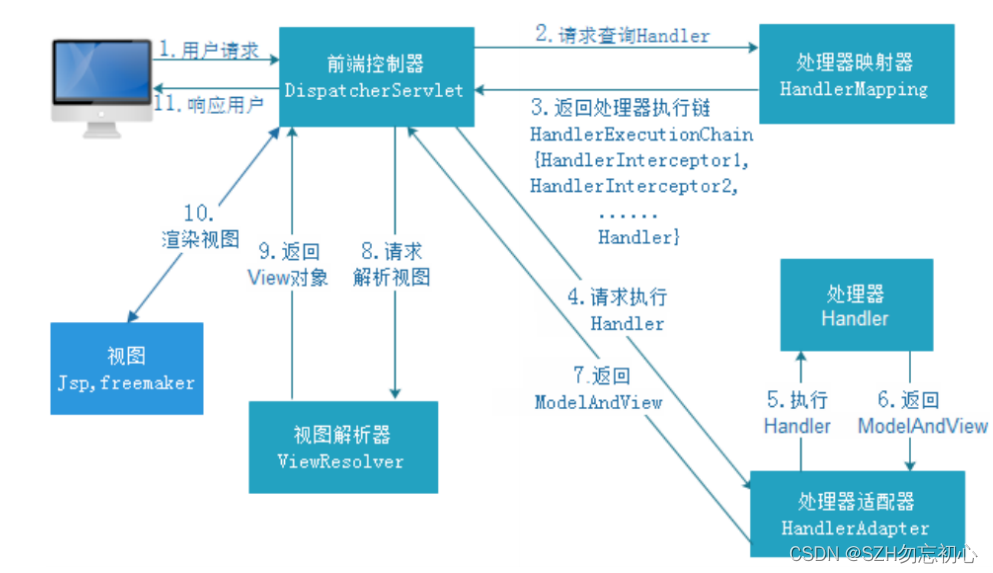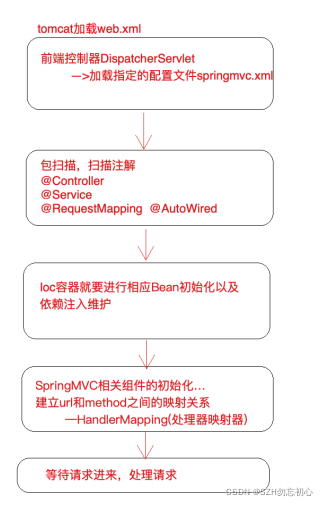Spring MVC 请求处理流程

流程说明:
- 第⼀步:⽤户发送请求⾄前端控制器DispatcherServlet
- 第⼆步:DispatcherServlet收到请求调⽤HandlerMapping处理器映射器
- 第三步:处理器映射器根据请求Url找到具体的Handler(后端控制器),⽣成处理器对象及处理器拦截器(如果 有则⽣成)⼀并返回DispatcherServlet
- 第四步:DispatcherServlet调⽤HandlerAdapter处理器适配器去调⽤Handler
- 第五步:处理器适配器执⾏Handler
- 第六步:Handler执⾏完成给处理器适配器返回ModelAndView
- 第七步:处理器适配器向前端控制器返回 ModelAndView,ModelAndView 是SpringMVC 框架的⼀个底层对 象,包括 Model 和 View
- 第⼋步:前端控制器请求视图解析器去进⾏视图解析,根据逻辑视图名来解析真正的视图。
- 第九步:视图解析器向前端控制器返回View
- 第⼗步:前端控制器进⾏视图渲染,就是将模型数据(在 ModelAndView 对象中)填充到 request - 域
- 第⼗⼀步:前端控制器向⽤户响应结果
⼿写 MVC 框架

手写MVC框架之注解开发:
- LagouAutowired
import java.lang.annotation.*;
@Documented
@Target(ElementType.FIELD)
@Retention(RetentionPolicy.RUNTIME)
public @interface LagouAutowired {
String value() default "";
}
- LagouController
import java.lang.annotation.*;
@Documented
@Target(ElementType.TYPE)
@Retention(RetentionPolicy.RUNTIME)
public @interface LagouController {
String value() default "";
}
- LagouService
import java.lang.annotation.*;
@Documented
@Target(ElementType.TYPE)
@Retention(RetentionPolicy.RUNTIME)
public @interface LagouService {
String value() default "";
}
- LagouRequestMapping
import java.lang.annotation.*;
@Documented
@Target({ElementType.TYPE, ElementType.METHOD})
@Retention(RetentionPolicy.RUNTIME)
public @interface LagouRequestMapping {
String value() default "";
}
- Pojo类Handler
import java.lang.reflect.Method;
import java.util.HashMap;
import java.util.Map;
import java.util.regex.Pattern;
/**
* 封装handler⽅法相关的信息
*/
public class Handler {
private Object controller; // method.invoke(obj,)
private Method method;
private Pattern pattern; // spring中url是⽀持正则的
private Map<String,Integer> paramIndexMapping; // 参数顺序,是为了进⾏参数绑定,key是参数名,value代表是第⼏个参数 <name,2>
public Handler(Object controller, Method method, Pattern pattern) {
this.controller = controller;
this.method = method;
this.pattern = pattern;
this.paramIndexMapping = new HashMap<>();
}
public Object getController() {
return controller;
}
public void setController(Object controller) {
this.controller = controller;
}
public Method getMethod() {
return method;
}
public void setMethod(Method method) {
this.method = method;
}
public Pattern getPattern() {
return pattern;
}
public void setPattern(Pattern pattern) {
this.pattern = pattern;
}
public Map<String, Integer> getParamIndexMapping() {
return paramIndexMapping;
}
public void setParamIndexMapping(Map<String, Integer> paramIndexMapping) {
this.paramIndexMapping = paramIndexMapping;
}
}
- web.xml
<!DOCTYPE web-app PUBLIC
"-//Sun Microsystems, Inc.//DTD Web Application 2.3//EN"
"http://java.sun.com/dtd/web-app_2_3.dtd" >
<web-app>
<display-name>Archetype Created Web Application</display-name>
<servlet>
<servlet-name>lgoumvc</servlet-name>
<servlet-class>com.lagou.edu.mvcframework.servlet.LgDispatcherServlet</servlet-class>
<init-param>
<param-name>contextConfigLocation</param-name>
<param-value>springmvc.properties</param-value>
</init-param>
</servlet>
<servlet-mapping>
<servlet-name>lgoumvc</servlet-name>
<url-pattern>/*</url-pattern>
</servlet-mapping>
</web-app>
- springmvc.xml
scanPackage=com.lagou.demo
- LgDispatcherServlet
import com.lagou.edu.mvcframework.annotations.LagouAutowired;
import com.lagou.edu.mvcframework.annotations.LagouController;
import com.lagou.edu.mvcframework.annotations.LagouRequestMapping;
import com.lagou.edu.mvcframework.annotations.LagouService;
import com.lagou.edu.mvcframework.pojo.Handler;
import org.apache.commons.lang3.StringUtils;
import javax.servlet.ServletConfig;
import javax.servlet.ServletException;
import javax.servlet.http.HttpServlet;
import javax.servlet.http.HttpServletRequest;
import javax.servlet.http.HttpServletResponse;
import java.io.File;
import java.io.IOException;
import java.io.InputStream;
import java.lang.reflect.Field;
import java.lang.reflect.InvocationTargetException;
import java.lang.reflect.Method;
import java.lang.reflect.Parameter;
import java.util.*;
import java.util.regex.Matcher;
import java.util.regex.Pattern;
public class LgDispatcherServlet extends HttpServlet {
private Properties properties = new Properties();
private List<String> classNames = new ArrayList<>(); // 缓存扫描到的类的全限定类名
// ioc容器
private Map<String,Object> ioc = new HashMap<String,Object>();
// handlerMapping
// private Map<String,Method> handlerMapping = now HashMap<>();
// 存储url和Method之间的映射关系
private List<Handler> handlerMapping = new ArrayList<>();
/**
* 初始化方法
* @param config
* @throws ServletException
*/
@Override
public void init(ServletConfig config) throws ServletException {
// 1. 加载配置⽂件 springmvc.properties
String contextConfigLocation = config.getInitParameter("contextConfigLocation");
doLoadConfig(contextConfigLocation);
// 2. 扫描相关的类,扫描注解
doScan(properties.getProperty("scanPackage"));
// 3. 初始化bean对象(实现ioc容器,基于注解)
doInstance();
// 4. 实现依赖注⼊ ->属性赋值
doAutoWired();
// 5. 构造⼀个HandlerMapping处理器映射器,将配置好的url和Method建⽴映射关系
initHandlerMapping();
System.out.println("lagou mvc 初始化完成....");
// 等待请求进⼊,处理请求
}
/**
* 最关键的环节:构造⼀个HandlerMapping处理器映射器
* ⽬的:将url和method建⽴关联
*/
private void initHandlerMapping() {
if (ioc.isEmpty()) {
return;
}
for (Map.Entry<String, Object> entry : ioc.entrySet()) {
// 获取ioc中当前遍历的对象的class类型
Class<?> aClass = entry.getValue().getClass();
// 只处理controller层,不处理service层
if (!aClass.isAnnotationPresent(LagouController.class)) {
continue;
}
String baseUrl = "";
if (aClass.isAnnotationPresent(LagouRequestMapping.class)) {
LagouRequestMapping annotation = aClass.getAnnotation(LagouRequestMapping.class);
baseUrl = annotation.value(); // 等同于 /demo
}
// 获取⽅法
Method[] methods = aClass.getMethods();
for (int i = 0; i < methods.length; i++) {
Method method = methods[i]; // ⽅法没有标识LagouRequestMapping,就不处理
if (!method.isAnnotationPresent(LagouRequestMapping.class)) {
continue;
}
// 如果标识,就处理
LagouRequestMapping annotation = method.getAnnotation(LagouRequestMapping.class);
String methodUrl = annotation.value(); // /query
String url = baseUrl + methodUrl; // 计算出来的url /demo/query
// 把method所有信息及url封装为⼀个Handler
Handler handler = new Handler(entry.getValue(),method, Pattern.compile(url));
// 计算⽅法的参数位置信息
// query(HttpServletRequest request, HttpServletResponse response,String name)
Parameter[] parameters = method.getParameters();
for (int j = 0; j < parameters.length; j++) {
Parameter parameter = parameters[j];
if(parameter.getType() == HttpServletRequest.class || parameter.getType() == HttpServletResponse.class) {
// 如果是request和response对象,那么参数名称写HttpServletRequest和HttpServletResponse
handler.getParamIndexMapping().put(parameter.getType().getSimpleName(), j);
} else {
handler.getParamIndexMapping().put(parameter.getName(), j); // <name,2>
}
}
// 建⽴url和method之间的映射关系(map缓存起来)
handlerMapping.add(handler);
}
}
}
/**
* 实现依赖注⼊
*/
private void doAutoWired() {
if (ioc.isEmpty()) {
return;
}
// 有对象,再进⾏依赖注⼊处理
// 遍历ioc中所有对象,查看对象中的字段,是否有@LagouAutowired注解,如果有需要维护依赖注⼊关系
for(Map.Entry<String,Object> entry: ioc.entrySet()) {
// 获取bean对象中的字段信息
Field[] declaredFields = entry.getValue().getClass().getDeclaredFields();
// 遍历判断处理
for (int i = 0; i < declaredFields.length; i++) {
Field declaredField = declaredFields[i];
// @LagouAutowired private IDemoService demoService;
if (!declaredField.isAnnotationPresent(LagouAutowired.class)) {
continue;
}
// 有该注解
LagouAutowired annotation = declaredField.getAnnotation(LagouAutowired.class);
String beanName = annotation.value();
// 需要注⼊的bean的id
if("".equals(beanName.trim())) {
// 没有配置具体的bean id,那就需要根据当前字段类型注⼊(接⼝注⼊)IDemoService
beanName = declaredField.getType().getName();
}
// 开启赋值
declaredField.setAccessible(true);
try {
declaredField.set(entry.getValue(), ioc.get(beanName));
} catch (IllegalAccessException e) {
e.printStackTrace();
}
}
}
}
/**
* ioc容器
* 基于classNames缓存的类的全限定类名,以及反射技术,完成对象创建和管理
*/
private void doInstance() {
if (classNames.size() == 0) return;
try {
for (int i = 0; i < classNames.size(); i++) {
String className = classNames.get(i); // com.lagou.demo.controller.DemoController
// 反射
Class<?> aClass = Class.forName(className);
// 区分controller,区分service
if(aClass.isAnnotationPresent(LagouController.class)) {
// controller的id此处不做过多处理,不取value了,就拿类的⾸字⺟⼩写作为id,保存到ioc中
String simpleName = aClass.getSimpleName();// DemoController
String lowerFirstSimpleName = lowerFirst(simpleName); // demoController
Object o = aClass.newInstance();
ioc.put(lowerFirstSimpleName, o);
} else if (aClass.isAnnotationPresent(LagouService.class)) {
LagouService annotation = aClass.getAnnotation(LagouService.class);
//获取注解value值
String beanName = annotation.value();
// 如果指定了id,就以指定的为准
if(!"".equals(beanName.trim())) {
ioc.put(beanName, aClass.newInstance());
} else {
// 如果没有指定,就以类名⾸字⺟⼩写
beanName = lowerFirst(aClass.getSimpleName());
ioc.put(beanName, aClass.newInstance());
}
// service层往往是有接⼝的,⾯向接⼝开发,此时再以接⼝名为id,放⼊⼀份对象到ioc中,便于后期根据接⼝类型注⼊
Class<?>[] interfaces = aClass.getInterfaces();
for (int j = 0; j < interfaces.length; j++) {
Class<?> anInterface = interfaces[j];
// 以接⼝的全限定类名作为id放⼊
ioc.put(anInterface.getName(), aClass.newInstance());
}
} else {
continue;
}
}
} catch (Exception e) {
e.printStackTrace();
}
}
/**
* ⾸字⺟⼩写⽅法
* @param str
* @return
*/
public String lowerFirst(String str) {
char[] chars = str.toCharArray();
if ('A' <= chars[0] && chars[0] <= 'Z') {
chars[0] += 32;
}
return String.valueOf(chars);
}
/**
* 扫描类
* scanPackage: com.lagou.demo package----> 磁盘上的⽂件夹(File) com/lagou/demo
* @param scanPackage
*/
private void doScan(String scanPackage) {
String scanPackagePath = Thread.currentThread().getContextClassLoader().getResource("").getPath() + scanPackage.replaceAll("\\.", "/");
File pack = new File(scanPackagePath);
File[] files = pack.listFiles();
for (File file : files) {
if (file.isDirectory()) {
// ⼦package
// 递归
doScan(scanPackage + "." + file.getName()); // com.lagou.demo.controller
} else if (file.getName().endsWith(".class")) {
String className = scanPackage + "." + file.getName().replaceAll(".class", "");
classNames.add(className);
}
}
}
/**
* 加载配置⽂件
* @param contextConfigLocation
*/
private void doLoadConfig(String contextConfigLocation) {
InputStream resourceAsStream = this.getClass().getClassLoader().getResourceAsStream(contextConfigLocation);
try {
properties.load(resourceAsStream);
} catch (IOException e) {
e.printStackTrace();
}
}
/**
* 接收处理请求
* @param req
* @param resp
* @throws ServletException
* @throws IOException
*/
@Override
protected void doGet(HttpServletRequest req, HttpServletResponse resp) throws ServletException, IOException {
doPost(req, resp);
}
/**
* 接收处理请求
* @param req
* @param resp
* @throws ServletException
* @throws IOException
*/
@Override
protected void doPost(HttpServletRequest req, HttpServletResponse resp) throws ServletException, IOException {
// 处理请求:根据url,找到对应的Method⽅法,进⾏调⽤
// 获取uri
//String requestURI = req.getRequestURI();
//Method method = handlerMapping.get(requestURI);
// 获取到⼀个反射的⽅法
// 反射调⽤,需要传⼊对象,需要传⼊参数,此处无法完成调⽤,没有把对象缓存起来,也没有参数!!!!改造initHandlerMapping();
// method.invoke()
// 根据uri获取到能够处理当前请求的hanlder(从handlermapping中(list))
Handler handler = getHandler(req);
if (handler == null) {
resp.getWriter().write("404 not found");
return;
}
// 参数绑定
// 获取所有参数类型数组,这个数组的⻓度就是我们最后要传⼊的args数组的⻓度
Class<?>[] parameterTypes = handler.getMethod().getParameterTypes();
// 根据上述数组⻓度创建⼀个新的数组(参数数组,是要传⼊反射调⽤的)
Object[] paraValues = new Object[parameterTypes.length];
// 以下就是为了向参数数组中塞值,⽽且还得保证参数的顺序和⽅法中形参顺序⼀致
Map<String, String[]> parameterMap = req.getParameterMap();
// 遍历request中所有参数 (填充除了request,response之外的参数)
for(Map.Entry<String,String[]> param: parameterMap.entrySet()) {
// name=1&name=2 name [1,2]
String value = StringUtils.join(param.getValue(), ","); // 如同 1,2
// 如果参数和⽅法中的参数匹配上了,填充数据
if (!handler.getParamIndexMapping().containsKey(param.getKey())) {
continue;
}
// ⽅法形参确实有该参数,找到它的索引位置,对应的把参数值放⼊paraValues
Integer index = handler.getParamIndexMapping().get(param.getKey());
//name在第 2 个位置
paraValues[index] = value;
// 把前台传递过来的参数值填充到对应的位置去
}
//request,response对象直接取出就可以
int requestIndex = handler.getParamIndexMapping().get(HttpServletRequest.class.getSimpleName());// 0
paraValues[requestIndex] = req;
int responseIndex = handler.getParamIndexMapping().get(HttpServletResponse.class.getSimpleName());// 1
paraValues[responseIndex] = resp;
// 最终调⽤handler的method属性
try {
// Pojo类Handler
handler.getMethod().invoke(handler.getController(), paraValues);
} catch (IllegalAccessException e) {
e.printStackTrace();
} catch (InvocationTargetException e) {
e.printStackTrace();
}
}
/**
* 根据请求request获取对应的Handler对象
* @param req
* @return
*/
private Handler getHandler(HttpServletRequest req) {
if (handlerMapping.isEmpty()) {
return null;
}
String url = req.getRequestURI();
for (Handler handler : handlerMapping) {
Matcher matcher = handler.getPattern().matcher(url);
if (!matcher.matches()) {
continue;
}
return handler;
}
return null;
}
}
Spring MVC请求参数绑定
-
默认⽀持 Servlet API 作为⽅法参数
-
绑定简单类型参数
简单数据类型:⼋种基本数据类型及其包装类型
参数类型推荐使⽤包装数据类型,因为基础数据类型不可以为null
整型:Integer、int
字符串:String
单精度:Float、float
双精度:Double、double
布尔型:Boolean、boolean
说明:对于布尔类型的参数,请求的参数值为true或false。或者1或0
/*
* SpringMVC 接收简单数据类型参数 url:/demo/handle03?id=1
*
* 注意:接收简单数据类型参数,直接在handler方法的形参中声明即可,框架会取出参数值然后绑定到对应参数上
* 要求:传递的参数名和声明的形参名称保持一致
*/
@RequestMapping("/handle03")
public ModelAndView handle03(@RequestParam("ids") Integer id,Boolean flag) {
Date date = new Date();
ModelAndView modelAndView = new ModelAndView();
modelAndView.addObject("date",date);
modelAndView.setViewName("success");
return modelAndView;
}
- 绑定Pojo包装对象参数
/*
* SpringMVC接收pojo类型参数 url:/demo/handle04?id=1&username=zhangsan
*
* 接收pojo类型参数,直接形参声明即可,类型就是Pojo的类型,形参名无所谓
* 但是要求传递的参数名必须和Pojo的属性名保持一致
*/
@RequestMapping("/handle04")
public ModelAndView handle04(User user) {
Date date = new Date();
ModelAndView modelAndView = new ModelAndView();
modelAndView.addObject("date",date);
modelAndView.setViewName("success");
return modelAndView;
}
- 绑定日期类型参数(需要配置自定义类型转换器)
1.DateConverter.java:
import org.springframework.core.convert.converter.Converter;
import java.text.ParseException;
import java.text.SimpleDateFormat;
import java.util.Date;
/**
* 自定义类型转换器
* S:source,源类型
* T:target:目标类型
*/
public class DateConverter implements Converter<String, Date> {
@Override
public Date convert(String source) {
// 完成字符串向日期的转换
SimpleDateFormat simpleDateFormat = new SimpleDateFormat("yyyy-MM-dd");
try {
Date parse = simpleDateFormat.parse(source);
return parse;
} catch (ParseException e) {
e.printStackTrace();
}
return null;
}
}
2.springmvc.xml中:
<!--注册自定义类型转换器-->
<bean id="conversionServiceBean" class="org.springframework.format.support.FormattingConversionServiceFactoryBean">
<property name="converters">
<set>
<bean class="com.lagou.edu.converter.DateConverter"></bean>
</set>
</property>
</bean>
3.controller类中的方法使用:
/**
* 绑定日期类型参数
* 定义一个SpringMVC的类型转换器 接口,扩展实现接口接口,注册你的实现
* @param birthday
* @return
*/
@RequestMapping("/handle06")
public ModelAndView handle06(Date birthday) {
Date date = new Date();ModelAndView modelAndView = new ModelAndView();
modelAndView.addObject("date",date);
modelAndView.setViewName("success");
return modelAndView;
}
- Restful 风格请求
/*
* restful get /demo/handle/15/lisi
*/
@RequestMapping(value = "/handle/{id}/{name}",method = {RequestMethod.GET})
public ModelAndView handlePut(@PathVariable("id") Integer id,@PathVariable("name") String username) {
Date date = new Date();
ModelAndView modelAndView = new ModelAndView();
modelAndView.addObject("date",date);
modelAndView.setViewName("success");
return modelAndView;
}
- Ajax Json交互
1)前端到后台:前端ajax发送json格式字符串,后台直接接收为pojo参数,使⽤注解@RequstBody
2)后台到前端:后台直接返回pojo对象,前端直接接收为json对象或者字符串,使⽤注解@ResponseBody
@RequestMapping("/handle07")
// 添加@ResponseBody之后,不再走视图解析器那个流程,而是等同于response直接输出数据
public @ResponseBody User handle07(@RequestBody User user) {
// 业务逻辑处理,修改name为张三丰
user.setName("张三丰");
return user;
}




















 1万+
1万+











 被折叠的 条评论
为什么被折叠?
被折叠的 条评论
为什么被折叠?








